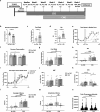Prefrontal cortex astroglia modulate anhedonia-like behavior
- PMID: 37696873
- PMCID: PMC10914619
- DOI: 10.1038/s41380-023-02246-1
Prefrontal cortex astroglia modulate anhedonia-like behavior
Abstract
Reductions of astroglia expressing glial fibrillary acidic protein (GFAP) are consistently found in the prefrontal cortex (PFC) of patients with depression and in rodent chronic stress models. Here, we examine the consequences of PFC GFAP+ cell depletion and cell activity enhancement on depressive-like behaviors in rodents. Using viral expression of diphtheria toxin receptor in PFC GFAP+ cells, which allows experimental depletion of these cells following diphtheria toxin administration, we demonstrated that PFC GFAP+ cell depletion induced anhedonia-like behavior within 2 days and lasting up to 8 days, but no anxiety-like deficits. Conversely, activating PFC GFAP+ cell activity for 3 weeks using designer receptor exclusively activated by designer drugs (DREADDs) reversed chronic restraint stress-induced anhedonia-like deficits, but not anxiety-like deficits. Our results highlight a critical role of cortical astroglia in the development of anhedonia and further support the idea of targeting astroglia for the treatment of depression.
© 2023. The Author(s).
Conflict of interest statement
In the past 3 years GS has served as consultant to Ancora, Aptinyx, Atai, Axsome Therapeutics, Biogen, Biohaven Pharmaceuticals, Boehringer Ingelheim International GmbH, Bristol-Myers Squibb, Clexio, Cowen, Denovo Biopharma, ECR1, EMA Wellness, Engrail Therapeutics, Freedom Biosciences, Gilgamesh, Intra-Cellular Therapies, Janssen, KOA Health, Levo therapeutics, Lundbeck, Merck, MiCure, Navitor Pharmaceuticals, Neurocrine, Novartis, Noven Pharmaceuticals, Otsuka, Perception Neuroscience, Praxis Therapeutics, Relmada Therapeutics, Sage Pharmaceuticals, Seelos Pharmaceuticals, Taisho Pharmaceuticals, Valeant, Vistagen Therapeutics, and XW Labs; and received research contracts from Johnson & Johnson/Janssen, Merck, and the Usona Institute over the past 36 months. GS holds equity in Biohaven Pharmaceuticals, Freedom Biosciences, Gilead, Relmada, and Tetricus. GS is a co-inventor on a US patent (#8,778,979) held by Yale University and a co-inventor on US Provisional Patent Application No. 047162-7177P1 (00754) filed on August 20, 2018, by Yale University Office of Cooperative Research. Conflict of Interest office. CP consults for Biohaven Pharmaceuticals, Transcend Therapeutics, Ceruvia Lifesciences, Freedom Biosciences, Nobilis Therapeutics, and F-Prime Ventures, and has received research from Biohaven, Transcend, and Freedom; these relationships are not related to the work described here. AL is employed by Bluerock Pharmaceuticals. Yale University has a financial relationship with Janssen Pharmaceuticals and may receive financial benefits from this relationship. The University has put multiple measures in place to mitigate this institutional conflict of interest. Questions about the details of these measures should be directed to Yale University’s. SC, YB, MC, PL, VD, RD, JM, RB, ES, and MB have no conflict of interest to disclose.
Figures




Update of
-
Prefrontal Cortex Astroglia Modulate Anhedonia-like Behavior.Res Sq [Preprint]. 2023 Jun 30:rs.3.rs-3093428. doi: 10.21203/rs.3.rs-3093428/v1. Res Sq. 2023. Update in: Mol Psychiatry. 2023 Nov;28(11):4632-4641. doi: 10.1038/s41380-023-02246-1. PMID: 37461693 Free PMC article. Updated. Preprint.
References
-
- Shorey S, Ng ED, Wong CHJ. Global prevalence of depression and elevated depressive symptoms among adolescents: a systematic review and meta-analysis. Br J Clin Psychol. 2022;61:287–305. - PubMed
-
- American Psychiatric Association. Manual diagnóstico y estadístico de los trastornos mentales: DSM-5. 5a edición. ed. Buenos Aires: Editorial Médica Panamericana; 2014. xlviii, 947.
-
- Kaufman J, Charney D. Comorbidity of mood and anxiety disorders. Depress Anxiety. 2000;12:69–76. - PubMed
MeSH terms
Grants and funding
LinkOut - more resources
Full Text Sources
Molecular Biology Databases
Research Materials
Miscellaneous

